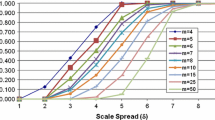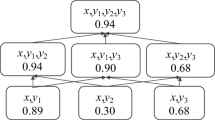Abstract
Conventional applications of data envelopment analysis (DEA) presume the existence of a set of similar decision making units, wherein each unit is evaluated relative to other members of the set. Often, however, the DMUs fall naturally into groupings, giving rise first to the problem of how to view the groups themselves as DMUs, and second to the issue of how to deal with several different ratings for any given DMU when groupings can be formed in different ways. In the present paper we introduce the concept of hierarchical DEA, where efficiency can be viewed at various levels. We provide a means for adjusting the ratings of DMUs at one level to account for the ratings received by the groups (into which these DMUs fall) at a higher level. We also develop models for aggregating different ratings for a DMU arising from different possible groupings. An application of these models to a set of power plants is given.
Similar content being viewed by others
References
Ali, I., W. Cook, and L. Seiford. (1991). “Strict no Weak Ordinal Relations for Multipliers in Data Envelopment Analysis.” Management Science 37(6), 733–738.
Banker, R., and R. Morey. (1986). “The Use of Categorical Variables in Data Envelopment Analysis.” Management Science 32(12), 1613–1627.
Banker, R., A. Charnes, and W. W. Cooper. (1984). “Some Models for Estimating Technical and Scale Efficiencies in Data Envelopment Analysis.” Management Science 30(9), 1078–1092.
Charnes, A., W. W. Cooper, and E. Rhodes (1978). “Measuring the Efficiency of Decision Making Units.” European Journal of Operational Research 2(6), 429–444.
Cook, W., M. Kress, and L. Seiford. (1996). “Data Envelopment Analysis in the Presence of Both Quantitative and Qualitative Factors.” Journal of the Operational Research Society, 47, 945–953.
Cook,W. D., Y. Roll, and A. Kazakov. (1990). “A DEA Model for Measuring the Relative Efficiency of Highway Maintenance Patrols.” INFOR 28(2), 113–124.
Golany, B. (1988). “A Note on Including Ordinal Relations Among Multipliers in Data Envelopment Analysis.” Management Science 34(8), 1029–1033.
Author information
Authors and Affiliations
Rights and permissions
About this article
Cite this article
Cook, W.D., Chai, D., Doyle, J. et al. Hierarchies and Groups in DEA. Journal of Productivity Analysis 10, 177–198 (1998). https://doi.org/10.1023/A:1018625424184
Issue Date:
DOI: https://doi.org/10.1023/A:1018625424184




